
Grand Stair Case of the Shuvalov Palace
Site of the Fabergé Museum in St. Petersburg and the Third International Fabergé Symposium
(Courtesy of “The Link of Times” Collection)
Join Fabergé Enthusiasts October 2-5, 2014
Fabergé Museum, St. Petersburg, Russia
A special message about the Symposium from Galina Korneva, President, and Irina Lynden, Secretary, Soroptomists International, Club Neva, in St. Petersburg, Russia:
The Third International Fabergé Symposium will take place on October 2-5, 2014, in St. Petersburg, Russia, to commemorate the 142nd Jubilee of the birth of the famous jeweler, and to celebrate the city where he lived and worked.
On behalf of the Russian members of the Organizing Committee, we cordially invite you to participate in the Symposium. Along with presentations by well-known Fabergé scholars, you will be able to take part in the discussions, see the shop locations of Fabergé’s contemporaries, and most importantly – visit the recently opened “The Link of Times” Museum where many decorative Fabergé objects are shown. An extensive professional and cultural program has been prepared to make your stay interesting, useful, and pleasant.
We strongly believe, that in this challenging time of political unrest, communication between people will enforce mutual understanding, build new friendships, and develop additional scholarly research.
We are looking forward to welcoming you in St. Petersburg!

Empress Maria Feodorovna by
Vladimir Makovsky, ca. 1912
(Wiki)
1902 – March 9-15 (Old Style). At least nineteen Fabergé eggs given to the Empresses Maria Feodorovna (1847-1928) and Alexandra Feodorovna (1872-1918) by Emperors Alexander III and Nicholas II were loaned to the Exhibition of Objets d’Art and Miniatures in the Baron von Dervis Mansion on the Angliskaia Naberezhnaia (English Embankment), St. Petersburg, Russia. No known exhibition catalog or checklist exist, however, scholars have identified the eggs from photographs published in 1993. For biographical details of the Baron, his family, and the exhibition see Fabergé, Tatiana, Proler, Lynette G. and Valentin V. Skurlov, The Fabergé Imperial Easter Eggs, 1997, 52-57. The Third Imperial Egg was seen again in public 112 years later – in 2014 – in London.
1917 – Third Imperial Egg survived the Russian Revolution and made it to the west.
1964 – March 6-7. Egg sold at auction (without identifying Fabergé marks in the lot #259 description) by Parke Bernet New York from the estate of Mrs. Rena Clark for $2450. Fabergé Research Newsletter, Winter 2011-2012
1993 – Ten von Dervis 1902 exhibition photographs in von Habsburg, Géza, and Marina Lopato, Fabergé: Imperial Jeweler, laid the foundation for later research by Fabergé scholars.
1997 and 2001 – Two books about the Imperial Easter Eggs were published:
- Fabergé, Tatiana, Proler, Lynette G., and Valentin V. Skurlov, The Fabergé Imperial Easter Eggs, 1997 (p. 55 – the authors state: “There are several eggs in this cabinet [Maria Feodorovna’s] which cannot be identified and it is probable that they are among the missing Imperial eggs.”
- Lowes, Will, and Christel Ludewig McCanless, Fabergé Eggs: A Retrospective Encyclopedia, 2001. Neither publication included the Third Imperial Egg, since it was believed by scholars the Blue Serpent Egg was the 1887 Egg. Many years later the missing pieces to the puzzle were found.
2007 – Anna and Vincent Palmade in “Two Lost Fabergé Imperial Eggs Discovered in an Archival Photograph” (Fabergé Research Newsletter, Eggs) discovered two new Fabergé eggs in the von Dervis photographs – the Cherub Egg with Chariot and the Nécessaire Egg (this image later identified more correctly as the Third Imperial Egg, when the 1964 auction catalog was found in July 2011).
2008 – Kieran McCarthy of Wartski from photographs of the 1949 Wartski exhibition confirmed the identity of the Nécessaire Egg. Findings published in Country Life, March 20, 2008, 60-1, “The Missing Nécessaire Egg” by Kieran McCarthy with an excerpt in the Fabergé Research Newsletter, Eggs.
2008 – Research by Annemiek Wintraecken revised the existing egg timeline long used by Fabergé scholars. She identified from the photographs found in 1993 the missing Third Imperial Egg, placed it and the 1896 Twelve Monogram Egg in their proper sequence in the new timeline. (Hillwood Estate, Museum, and Gardens officially redated the egg in 2014). “The Fabergé Imperial Easter Eggs: New Discoveries Revise Timeline” by Annemiek Wintraecken was published in the Fabergé Research Newsletter, Eggs.

von Dervis Showcase with
Third Imperial Egg Highlighted
(Courtesy Wartski)
2011 – After an interview with Kieran McCarthy in the Sunday Telegraph (London), August 13, 2011, “The £20M Imperial Egg Hunt”, the egg hunts goes public. This article posted on the internet and the 2008 revision of the long-standing timeline by Annemiek Wintraecken were significant clues. The detective work by the Palmades from 2007 onward, and the hard work of Kieran McCarthy and the staff at Wartski completed the search for the missing egg. The highlight for Fabergé enthusiasts was the four-day public viewing in 2014 after the egg had already sold to an anonymous collector for an undisclosed price.
2013 – Annemiek Wintraecken and Christel Ludewig McCanless in “Empress Marie Feodorovna’s Missing Fabergé Easter Eggs” summarized in Royal Russia Annual No. 3 all known details for eight missing eggs. The article is reproduced here for our readers with gracious permission by Paul Gilbert, publisher and editor of the annuals.
Missing eggs with links to webpages with additional information:
- 1886 Hen Egg with Sapphire Pendant (Survived the 1917 Russian revolution, disappeared after 1922) Fabergé Research Newsletter, Eggs
- 1887 Third Imperial Egg (Survived the 1917 Russian revolution, made it to the west, sold at auction in 1964, and now in 2014 is FOUND!) Fabergé Research Newsletter Eggs | Summer 11 (Special Edition) | Fall 11 | Winter 11-12


Comparison of the 1887 Third Imperial Egg in the 1902 von Dervis Exhibition
with 1964 Parke Bernet New York Auction Catalog Photograph - 1888 Cherub Egg with Chariot (Known from a reconstructed drawing made in 2007, revised in 2011) Fabergé Research Newsletter, Eggs | 04.08 (Anniversary Edition) | Winter 11-12



Maria Feodorovna Vitrine in von Dervis 1902 Exhibition, Palmade Drawing, 1888 Cherub Egg with Chariot and Its Reflection
- 1889 Nécessaire Egg (Pearl Egg) (Survived the 1917 Russian revolution, made it to the west, and in public view in London in 1949 and the early 1950s Wartski archives record it was sold to “a stranger”) Fabergé Research Newsletter Eggs | 04.08 (Anniversary Edition)

Nécessaire Egg in a 1949 Photograph
(Courtesy Wartski) - 1897 Mauve Egg with 3 Miniatures (Possibly the surprise is known) Annemiek Wintraecken with assistance from Elsebeth Welander-Berggren discusses the surprise in the Eggs column of this Fabergé Research Newsletter.
- 1902 Empire Nephrite Egg (Alexander III Medallion Egg, only sketchy details extant)
- 1903 Royal Danish Egg (Danish Jubilee Egg, known from an archival Fabergé photograph)
- 1909 Alexander III Commemorative Egg (Known from an archival Fabergé photograph)


1903 Royal Danish Egg and 1909 Alexander III Commemorative Egg
(Courtesy Tatiana Fabergé)
April 14-17. Third Imperial Egg on view at Wartski, 14 Grafton Street, London. Kieran McCarthy reflecting on the event summarized his joy in these words: The exhibition was a stellar success, we had 2270 visitors crowding in to see the Egg over the four days.
The world-wide media frenzy both in print, on the internet, radio, and television continued for days – a few selected videos (#1 and #2), and a detailed entry for the Third Imperial Egg in Wikipedia.
Among the throng of lucky viewers were several Fabergé Research Newsletter readers. It is my pleasure to share a few of their impressions and photos.
The rediscovered egg at Wartski is lovely. Tiny, in comparison to later eggs, and relatively restrained: fluted gold with minimal use of gems. My new favorite, without a doubt!
John Jenkins, United Kingdom:
A masterpiece of display by the Wartski jeweler and a lesson to others in how to show Fabergé pieces!
George W. Terrell, Jr., USA:
I went to see the Third Imperial Egg twice to continue my life-long passion of seeing all the known Fabergé Eggs – with this trip from the southern part of America to London the string of seeing 43 of the known 50 eggs is not broken.
Annemiek Wintraecken, The Netherlands:
For the exhibition the Wartski shop had been changed into a little box with blown-up photographs of the von Dervis 1902 exhibition as wall paneling. The Egg was very well lit in a glass show case with a black background in the middle of the room. Very, very nice and a bit like a fairy tale!

Annemiek Wintraecken, John Jenkins, George Terrell,
Ulla Tillander-Godenhielm, Bobbie Hardy
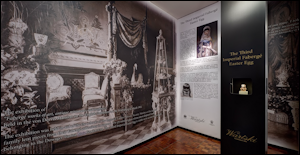
von Dervis Exhibition Panorama
with the Third Imperial Egg in a Show Case
(Courtesy Wartski London)

Annemiek Wintraecken and Kieran McCarthy – All Smiles!
(Courtesy John Jenkins)

Board from the Light Cruiser “Svetlana”, 1913
May 24, 2014 Znak-Auction, Moscow
(Shared by Paul Kulikovsky, Romanov News)

Nephrite Elephant Pendant
Confirmed by an Albert Holmström
Design Sketch June 2, 2014
Christie’s London Russian Art

Fabergé Silver Casket Based on the 1820 Poem,
Ruslan and Ludmilla by Alexander Pushkin
June 3, 2014 Sotheby’s London
Russian Works of Art, Fabergé and Icons

Fabergé Objects
June 3-4, 2014 Jackson’s International, Cedar Falls, Iowa
World Treasures: Important Russian, Asian, European & American Works

Fabergé Objects from a Single Owner Collection
June 4, 2014 Bonhams London Russian Sale
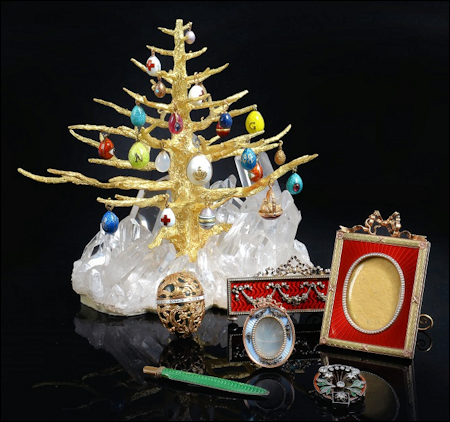
Fabergé Objects Included
June 11-12, 2014 Olivier Coutau-Bégarie, Paris Art Russe

Bell Push and Salt Cellar
June 11, 2014 Bruun Rasmussen Auctioneers, Copenhagen Russian Art and Antiques

Le Matin, Monday May 14, 1900


A. 1896 Fabergé Miniature on View in a 1997 Stockholm Exhibition
(Welander-Berggren, Elsebeth, Carl Fabergé: Goldsmith to the Tsar, 1997, 161, Photographs © Erik Cornelius, Nationalmuseum Stockholm)


B. 1897 Fabergé Miniature Surprise for the Mauve Easter Egg
(Forbes, Christopher, and Robyn Tromeur-Brenner,
Fabergé: The Forbes Collection, 1999, 42-45)
A. 1896 frame in a private collection (4½ inches, 11.5 cm.) Red heart with a XII ½ monogram with Mikhail Perhkin’s initials and an assay mark of St. Petersburg before 1896. When opened the leaves contain miniatures of four children and their father.
B. 1897 Mauve Egg surprise (3¼ inches, 8.3 cm.) with the date 1897 in diamonds on the strawberry red (also cited as scarlet) guilloché heart, marked K. Fabergé.
In the Fabergé literature the surprise for the missing Mauve Egg, the Easter gift in 1897 to Maria Feodorovna, has been attributed to a frame (B.) in the former Forbes Magazine Collection, now in the “The Link of Times” Collection. The frame set with the date 1897 in rose-cut diamonds opens as a three-leaf clover with each leaf holding a rose diamond-encircled photograph of Emperor Nicholas II and Alexandra with their first born child, Grand Duchess Olga. In the 1999 Forbes Magazine Collection catalogue raisonné the heart is described as strawberry red guilloché enamel.
Marina Lopato (1) found the bill of sale in the Russian State Historical Archives in St. Petersburg with these details “an Egg of mauve enamel with three miniatures – 3,500 silver roubles“. In von Habsburg and Lopato (2) the scarlet heart-shaped frame is identified as the surprise for the mauve Egg, and an invoice date of May 17, 1897, is cited.
The author of this article wonders if the strawberry red or scarlet color of the frame really blends with the mauve enamel Egg description, and if the suggested surprise frame is indeed part of the lost egg?
Another observation which is even more puzzling – would Fabergé have repeated a similar design concept in a smaller version for the Mauve Egg presented to the Empress in 1897?
My thanks to Elsebeth Berggren for the frame photographs not published in the 1997 catalog, because the miniature needed repairs and was not photographed for the exhibition.
References:
1. Lopato, Marina. “Fresh Light on Fabergé.” Apollo, January 1984, 43-49.
2. von Habsburg, Géza, and Marina Lopato. Fabergé: Imperial Jeweller, 1993, 186.
(Updates are posted in Exhibitions on the Fabergé Research Site)

Imperial Presentation Box, 1916
(Courtesy of the Royal Collection, London)
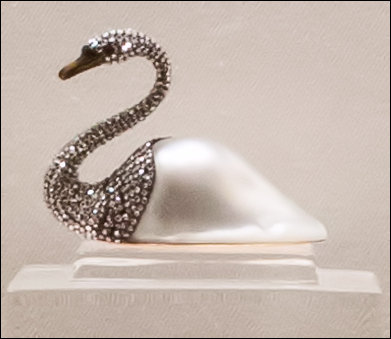
Elisabeth Balletta Swan
(Courtesy A La Vieille Russie)
The New York Fabergé dealer, A La Vieille Russie, presented in December 2013 a salute to the Wounded Warrior Project (WWP) with its exhibition, Animals As Art: Wearable and Collectible. The mission of the WWP charity is to foster the most successful, well-adjusted generation of wounded service members in our nation’s history.
A La Vieille Russie and Wartski will be exhibiting at Masterpiece London 2014 from June 26 – July 2, 2014.
Kremlin Museums have updated their website with a walk through the magnificent halls of the Kremlin, and without leaving your seat take a tour via an amazing 360 degree tour.
Virginia Museum of Fine Arts, Richmond: A small collection of Fabergé objects, including the Imperial Rock Crystal Easter Egg, will be on display in the European art galleries, while the VMFA’s Fabergé and Russian Decorative Arts collection is on an international tour. The objects will return to the museum in 2016 for the opening of the newly designed galleries.

Fabergé Items … of the State Museum Pavlovsk
(Courtesy of the Pavlovsk Palace Museum)
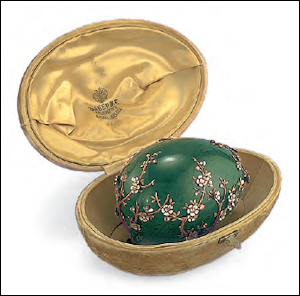
1901 Apple Blossom Egg
(Courtesy Adulf P. Goop Foundation Collection,
Liechtenstein Landesmuseum, Vaduz)
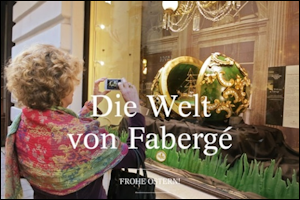
“Sugary Confection” Replica of the 1891 Memory of Azov Egg
(Courtesy of the Kunsthistorisches Museum, Vienna)
Fabergé at Harrods: A Loan Exhibition …
Dr. Géza von Habsburg in his introduction to the exhibition catalog states:
In 1913, a Swiss watch dealer, Gustave Loup, bought from Prince Kung in Peking a Fabergé clock with a crowing cockerel (reputedly a gift from the Russian Court), and later sold it to an American. Is anyone aware of a Fabergé piece which might fit this description? Provenance, surely rules out the two eggs with cockerels. Contact: Editors






